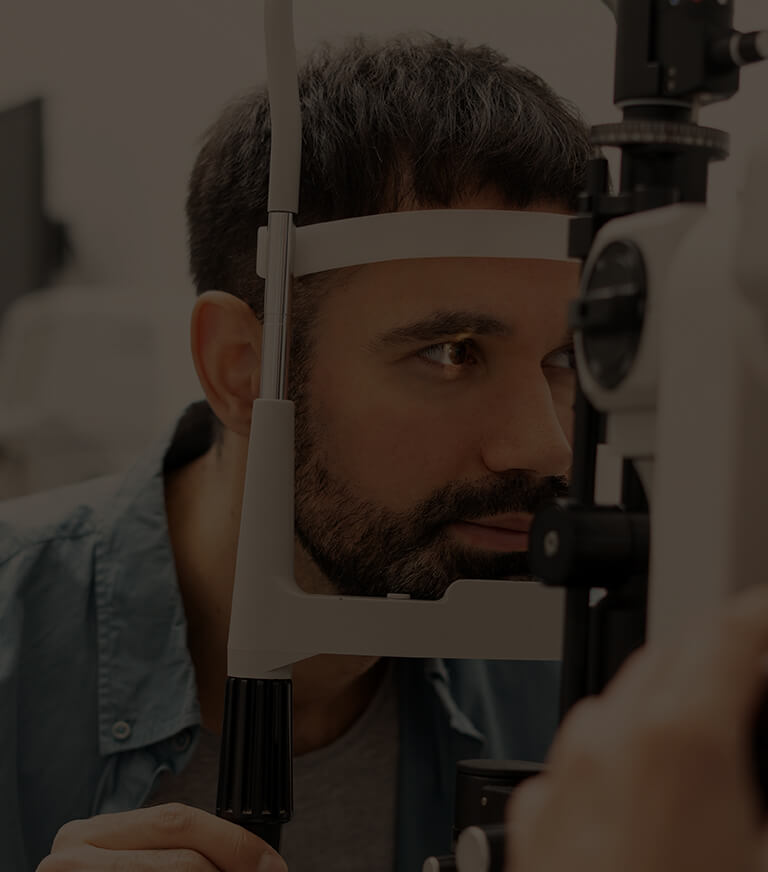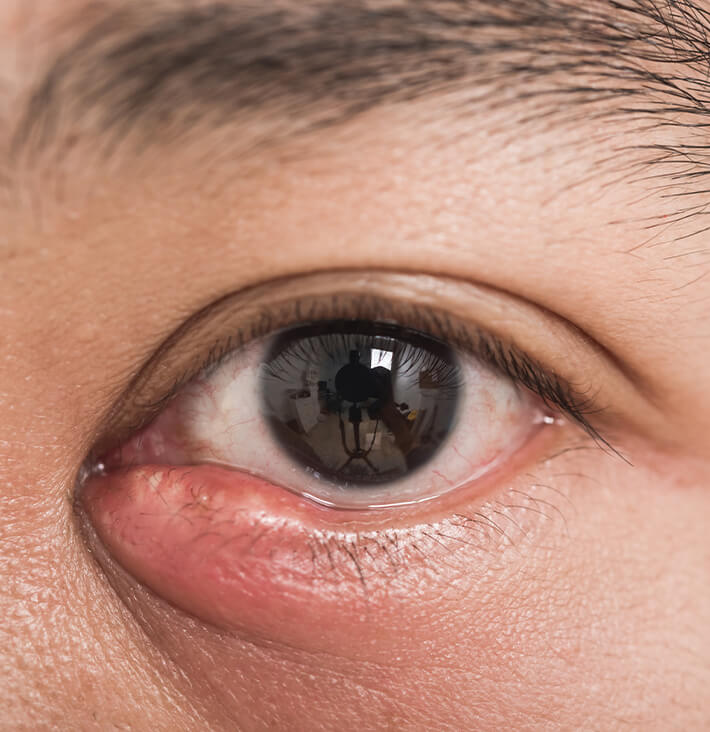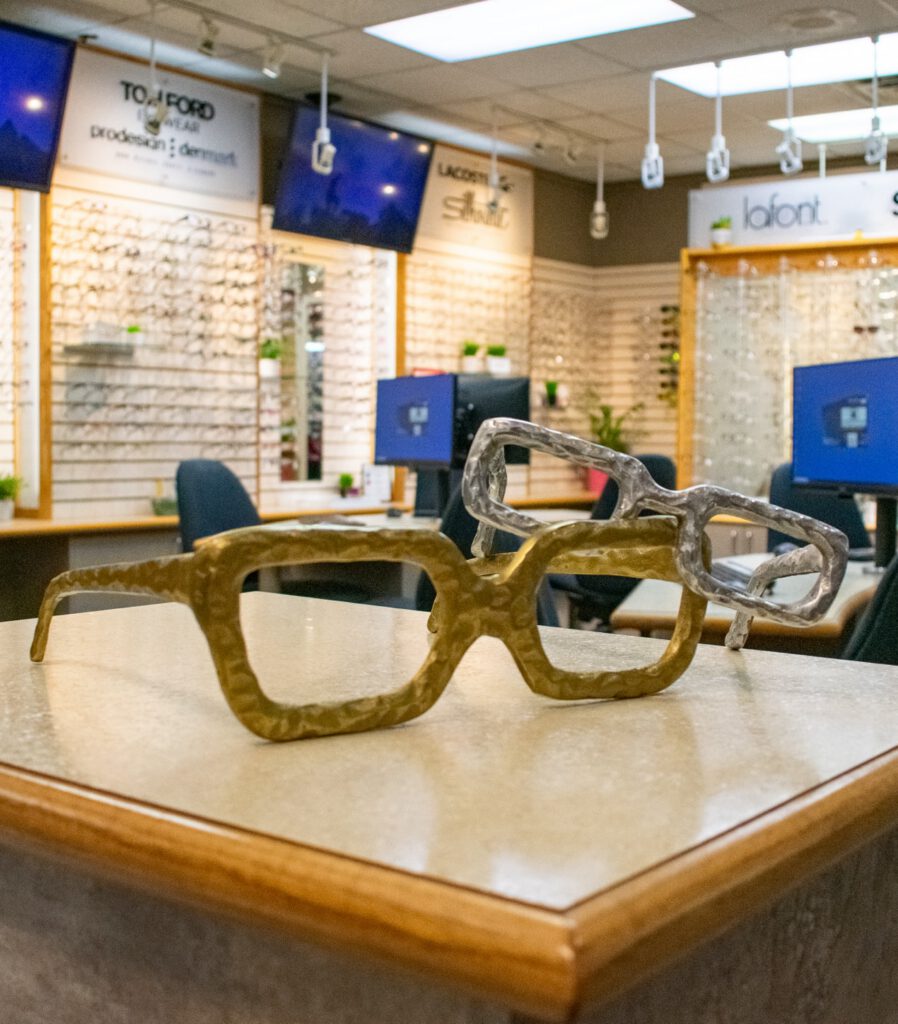Why Are My Eyes So Dry?
Your eyes might feel dry because they don’t make enough tears, or the tears you do make evaporate too quickly. […]

Many types of eye problems can affect your visual health. Whether the condition causes mild discomfort or vision loss, it’s crucial to detect and treat problems early. Prevention and early diagnosis can improve health and vision outcomes.
Monitoring changes to your eyes and vision can also decrease other health risks, as some medical conditions can be detected in an eye exam.
At Westmount Optometrists, we’re here to help, from initial diagnosis to managing eye conditions long-term. Regular comprehensive eye exams can help us watch for changes in eye health and prevent eye disease.

Regular eye exams help protect your health and manage vision problems. Our eye imaging technology, assessments, and discussions are crucial in detecting and treating many common eye conditions and diseases.
Our optometrists have a vast wealth of knowledge related to eye conditions and diseases. We’re also dedicated to learning about our patients’ unique eyes. By combining our experience and information gathered from individual assessments, we can help protect your eyes from common eye conditions and diseases.

Many eye diseases develop without noticeable symptoms during early stages. By the time you notice changes to your vision, the damage is often irreversible. Early detection increases our treatment options and reduces the likelihood of vision loss. Regular eye exams can help us monitor your eyes for signs of disease, allowing us to catch problems early.
We help to manage and monitor various eye diseases, including macular degeneration, glaucoma, cataracts, diabetic eye disease, and conjunctivitis. Whether treatment looks like a week of prescription eye drops or lifelong monitoring, we’re here to guide you every step of the way.
While most eye diseases develop without noticeable symptoms during early stages, if you do notice any sudden changes to your vision, such as flashes of light, tunnel vision, blurry vision, or floaters, contact us right away. We’ll get your eyes checked as soon as possible to rule out any serious concerns.
Age-related macular degeneration (AMD), while more common in patients over 55, can also be a complication from other conditions, including diabetes or degenerative myopia, which can occur in younger patients.
There are 2 forms of macular degeneration: dry and wet.
Dry AMD is milder and more common. The damage tends to progress more slowly. Wet AMD can progress faster, even suddenly. This typically results from leakage or bleeding around the macula, the part of the retina that helps us see central vision and fine details.
Symptoms of Wet AMD include:
Other significant risk factors include UV exposure, smoking, high blood pressure, and a family history of AMD.
Wet AMD can be treated with medication injections or surgery. Early detection is crucial to prevent vision loss caused by AMD.
Cataracts are cloudy spots that form in the normally clear lens in your eye. The cloudy spots can vary in size, affecting vision differently depending on how the cataract develops over time. Cataracts can affect anyone, but are more common as we age. Protecting your eyes from UV damage and eating foods rich in antioxidants can help slow the growth of cataracts.
Cataract symptoms include:
The recommended treatment can depend on how severely vision is impacted. We’ll also consider the patient’s comfort level. Common treatment options include prescription lenses and cataract surgery.
Conjunctivitis is an inflammation of the conjunctiva, or the clear tissue covering the white of the eye and the inner eyelids. Irritation causes the blood vessels in the conjunctiva to dilate, leading to bloodshot eyes.
Other common symptoms include light sensitivity, eye irritation, excessive tearing, and discharge (watery or mucousy).
Conjunctivitis can be caused by bacterial or viral infections spread by touching your eyes or face. Allergic conjunctivitis is not contagious, but it is uncomfortable. Allergy medications and eye drops can help alleviate symptoms.
The third type of conjunctivitis is caused by chemical irritation. This kind can be caused by perfume, smoke, or other chemical exposure. Flushing your eyes can help remove chemical irritants, but an eye exam can check for eye damage and determine whether further treatment is necessary.
Diabetic eye disease refers to a group of eye diseases that result from complications of diabetes. Anyone living with diabetes or prediabetes is at a higher risk of developing these complications. Consistently elevated blood sugar levels cause damage to the blood vessels in the eyes, which can cause permanent damage and even vision loss.
Diabetic eye disease includes diabetic retinopathy, diabetic macular edema, and retinal detachment. Managing blood sugar levels helps to avoid complications such as diabetic eye disease. Regular eye exams are also crucial to monitor your eye health and catch signs of complications early.
Glaucoma is a group of eye diseases that damage the optic nerve, which sends light signals from the eye to the brain. Damage to the optic nerve causes vision loss. There are multiple types of glaucoma, with most occurring because of increased intraocular pressure (IOP), or pressure inside the eye. It’s the leading cause of blindness in Canada.
Early detection is crucial to preventing vision loss, but many patients do not observe symptoms in the early stages of development. By measuring IOP and assessing vision regularly, our optometrists can diagnose changes to eye health that indicate glaucoma.
Floaters can appear as spots, squiggles, cobwebs, or various shadowy shapes. Although it may seem like floaters are crossing over your vision, they’re caused by protein deposits and cells inside the eye.
Flashes of light appearing in the corner of your eye or side vision are often a symptom of an eye condition. These flashes, called photopsia, can affect one or both eyes. The shapes of the vision distortion can vary, and can sometimes be referred to as “seeing stars.”
While often harmless, flashes and floaters can sometimes signal a more serious condition, such as retinal detachment. If you notice unfamiliar flashes or floaters, or see a sudden increase in frequency, contact us for an eye exam right away.
Optometrists use various eye imaging technologies and assessments to evaluate eye health and diagnose eye conditions. One common test type is measuring intraocular eye pressure (IOP). Monitoring eye pressure is crucial in detecting glaucoma, a common sight-stealing disease.
Eye pressure can indicate problems with fluid drainage, which can affect the optic nerve. The optic nerve is responsible for sending signals from our eyes to our brain. Our team at Westmount Optometrists uses Goldmann tonometry, non-contact tonometry, and the iCare tonometer to evaluate eye pressure.
Goldmann tonometry (or applanation tonometry) uses a small probe to gently flatten the surface of the eye.
The patient’s eyes are numbed with eye drops before the test. Dye is used, sometimes included in the eye drops or placed with a fine strip of paper. Then, the optometrist examines the patient’s eyes while focusing light with a slit lamp.
There is no discomfort during the test. However, the numbing eye drops can cause blurry vision or light sensitivity for a few hours after your appointment.
The iCare tonometer is a quicker alternative to applanation tonometry. The procedure is similar and still uses eye drops to limit patient discomfort.
The iCare device is handheld and is used to gently tap the surface of the cornea. The device instantly measures intraocular eye pressure (IOP).
Non-contact tonometry is also known as the “puff test.” The testing instrument does not touch the patient’s eye, and no eye drops are required. Although there is no discomfort, it can be surprising!
The device measures intraocular eye pressure (IOP) using a tiny beam of light. When the air puff reaches the eye, the pressure temporarily flattens the cornea, causing the beam of light to move. The device calculates the light movement to measure eye pressure.

Many eye diseases and conditions can develop slowly but can affect vision and eye health over time. Early diagnosis and prevention can protect your health and sight.
Visit us regularly for an eye checkup. The more often we see you, the better we can help you manage your eye health. Book your regular eye exam now!
At the corner of Springbank Drive and Wonderland Road, our clinic offers plenty of parking out front.






Your eyes might feel dry because they don’t make enough tears, or the tears you do make evaporate too quickly. […]
OHIP provides coverage for eye exams based on your age and specific medical conditions you may have. […]
Yes, many people with dry eyes can wear contact lenses comfortably with the right strategy and lens choice. […]
Age-related macular degeneration is one of the leading causes of vision loss among Canadians over the age of 50, with more than 2.5 million people affected.
[…]
Read More… from How Common is Age-Related Macular Degeneration in Canada?
Your eyes and brain need time to adapt to your new lenses, and this adjustment period varies from person to person. Some lucky folks feel comfortable within a day or two, while others might need up to two weeks to fully settle in. […]
Read More… from How Long Does it Take to Adjust to New Eyeglasses?
Often better known as “transition lenses”, photochromic lenses are not your typical sunglasses. These lenses automatically adjust their lens tint based on UV light exposure, remaining clear indoors and becoming darker when exposed to sunlight, even on cloudy days.
[…]
These eyeglasses use specially designed lenses that cause light to focus on the eye in a way that slows myopia progression in children.
[…]
The key difference? Dry eyes are typically caused by poor tear production or when your tears evaporate too quickly, while eye allergies result from your immune system reacting to allergens like pollen or dust. The symptoms may overlap, but the causes—and treatments—are very different.
[…]
Read More… from Dry Eyes or Allergies: How to Identify the Cause of Your Eye Discomfort
One of the easiest ways to determine if your sunglasses are polarized is by using the reflection or screen test. […]
Read More… from How Do You Know if Sunglasses Are Polarized?
By determining your face shape—whether it’s oval, round, square, or another—you can select glasses that best suit your unique features, ensuring both a flattering fit and a boost in confidence. […]
Dry eye syndrome can be uncomfortable and disruptive to your eye health, affecting millions of people worldwide. Whether you’re dealing with persistent dryness, redness, or irritation, finding relief often starts with the right type of eye drops. These tiny bottles of liquid comfort can make a significant difference when chosen and used correctly. Types of […]
When considering laser eye surgery, one of the most common questions patients ask is about timing. How long it will take is a concern that may influence your decision, especially if you’re juggling work, family responsibilities, or other obligations. Fortunately, laser eye surgery, particularly LASIK, is a quick and efficient procedure designed to minimize disruption […]
Glaucoma, a complex eye condition, can lead to serious vision damage if left untreated. It’s a subtle, progressive condition that tends to develop without obvious warning signs. Regular eye examinations are key to catching conditions like glaucoma—they’re the easiest way to detect problems before they damage your vision. But what causes glaucoma in the first […]
Tears are such an integral part of your eye health that you may not think much about them until something feels off. Have you ever noticed your tears stinging your eyes, leaving you curious—and maybe a bit concerned—about why? While we often associate tears with emotion or keeping our eyes comfortably moist, there are several […]
Navigating a prescription can feel like reading a secret code. But whether you’re squinting at tiny text on a screen or admiring the vibrant colours of a sunset, we all treasure clear vision—so an accurate prescription is a must!
Contact lens prescriptions and glasses prescriptions are not the same. So whether you’re sticking with the cozy familiarity of your favourite pair of glasses or making the jump to the comfort offered by contact lenses, your optometrist can help you see the world clearly.
[…]
Read More… from Are Contact Lens Prescriptions & Glasses Prescriptions the Same?
For many, an eye exam is a routine check-up that can ensure eye health, but did you know it’s also a powerful tool for detecting diseases? Regular eye exams can reveal much more about your overall health than you might expect.
Today, we’ll explore the various conditions such as diabetes, high blood pressure, high cholesterol, autoimmune disorder, neurological conditions, and cancer that can be identified during an eye exam, offering you peace of mind and a deeper understanding of your health.
[…]
Dry eye syndrome is a common and often chronic condition that affects millions of people around the world. While it might seem like a minor inconvenience, dry eye can lead to significant discomfort and even impact your vision. One of the symptoms that sufferers frequently report is blurry vision. But can dry eye cause blurry […]
Navigating the world of contact lenses can be overwhelming, with so many options available. From different styles and types to advanced lens designs, it’s easy to get lost. Your optometrist can be a valuable guide in this process, helping you find the perfect fit for your vision and lifestyle. One option to consider is rigid […]
The sun may be beautiful, but that doesn’t mean it’s harmless. It’s essential to always protect your eyes from UV radiation to keep your eyes healthy and your vision clear. But if you’ve ever thought about picking up a new pair of sunglasses, you’ve probably noticed words like “polarized” and “non-polarized.” What does this mean? […]
Regular eye examinations are essential for maintaining good vision health and detecting any potential problems early on. The frequency of your eye exams depends on several factors, including age, overall health, and any existing eye conditions. Here are some general guidelines to follow: Children should have their first comprehensive eye examination at 6 months of […]
Experiencing the discomfort of dry eyes can be more than just an irritation—it can significantly impact your quality of life. But what if the foods you eat could help you prevent and manage symptoms like stinging sensations? Now may be the time to book an eye exam and get personal advice on your eye nutrition. […]
How long eye strain lasts can vary in individuals. However, eye strain symptoms can subside after an hour when you stop the activity that caused it. Prolonged eye strain could indicate an underlying eye problem. […]
If you’re tired of wearing glasses and considering switching to contact lenses, or maybe you’re already a seasoned contact lens wearer and want to learn more about the fitting process, you’ve come to the right place. Contact lenses have revolutionized how we see and experience the world, providing a convenient and comfortable alternative to traditional […]
If you keep waking up with dry eyes, several underlying causes could exist. From sleeping habits to dry air, allergies, and eye strain, identifying the root cause of the problem is the first step to finding relief. […]
Yes, your eyes can get “sunburns” or, more accurately, “photokeratitis,” but there are certain signs and symptoms to watch out for so you can protect your vision. […]
Eye exams generally don’t take too much out of your day, usually about 30 to 60 minutes, depending on your needs for diagnosing and managing eye issues […]
There are some instances where this mode could help lower your risk of straining your eyes. However, it can also do the opposite, so it’s important to know when to use it. […]
To prevent dry eye with contact lenses, you need the right contact lens type, replacement schedule, contact solution, and home habits to keep your eyes hydrated during prolonged wear. […]
Sunglasses aren’t only a stylish accessory, but they’re also crucial to protecting your eyes from harsh ultraviolet (UV) rays. […]
Eye drops are often one of the first treatments or solutions recommended for many common eye problems–including allergies, infections, and dry eye. Rewetting eye drops can also significantly benefit patients wearing contact lenses. But when your eyes are irritated, or you have a heightened blink reflex, it can be challenging to put in your own […]
If you’re suddenly dealing with an eye problem like dry eyes, you’ll likely do everything possible to ease the discomfort. But when your eyes are working properly, it can be easy to ignore them. And without any troubling symptoms, how easy is it to think about skipping your next comprehensive eye examination? Unfortunately, there’s much […]
Many people who require vision correction choose to wear contact lenses. This choice may be because they find them more comfortable, want a wider range of clear vision, or prefer the aesthetics going frameless grants them. If you’re one of those who decided to go with contact lenses, you may already know the basics. Your […]
Dry eye symptoms can make your eyes feel tired, irritated, and uncomfortable. Much like a runny nose or plugged ears, dry eye can feel impossible to ignore. Except dry eye doesn’t resolve quite as easily as we’d like. Dry eye can be frustrating to deal with, but there are many treatments available to help alleviate […]
Read More… from 6 Reasons Why Scleral Lenses Can Solve Your Dry Eye Syndrome
Polarized sunglasses are a popular choice for anyone who loves the outdoors. These special lenses reduce glare while keeping your vision clear. These sunglasses are usually on the more expensive side, especially if you get prescription lenses. Taking proper care of your polarized lenses will help keep them working properly for years to come. What […]
As sunny seasons approach, you might be asking yourself, “do I need prescription sunglasses?” If you normally require prescription eyewear, the answer is yes. We’re going to explore why this is important and how prescription sunglasses can help you achieve a better lifestyle. The first step in finding sunglasses that help you see better and […]